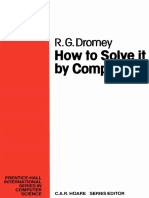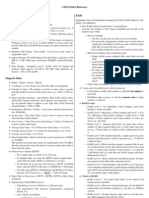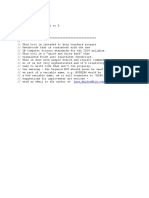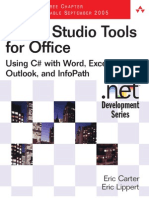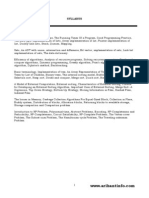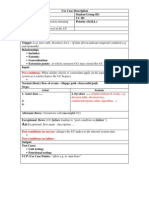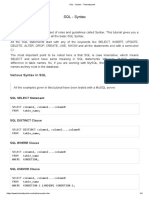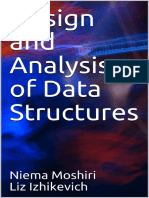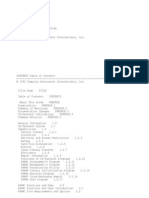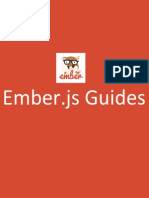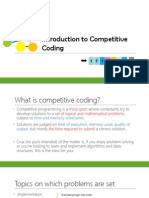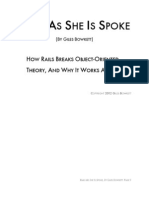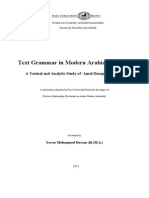0 ratings0% found this document useful (0 votes)
588 views463 pagesHow To Solve It by Computer
Uploaded by
anh tài dươngCopyright
© © All Rights Reserved
We take content rights seriously. If you suspect this is your content, claim it here.
Available Formats
Download as PDF or read online on Scribd
0 ratings0% found this document useful (0 votes)
588 views463 pagesHow To Solve It by Computer
Uploaded by
anh tài dươngCopyright
© © All Rights Reserved
We take content rights seriously. If you suspect this is your content, claim it here.
Available Formats
Download as PDF or read online on Scribd
You are on page 1/ 463
PRENTICE-HALL
SCI ENCE
R.G. Dromey
How fo Solve it
by Computer
C.A.R. HOARE SERIES EDITOR
HOW TO SOLVE IT
BY COMPUTER
R. G. DROMEY
Department of Computing Science
The University of Wollongong
ENGLEWOOD CLIFFS, NEW JERSEY LONDON NEW DELHI
SINGAPUKE «= SYUNEY = GUKYU)— TURUNTU WELLINGTON
Library of Congress Cataloging in Publication Daa
DROMEY,R.G, — 1946-
How 10 Soive it by Computer,
Bibliography: p.
Includes index
1. Mathematics—-Daia processing
2. Problem solving—Data processing
2, teetronic aigitat computers—rrogramming
1. Title.
QA76.95.D76 S194 B1-19164
ISBN 0.13-433095.9 AACR?
ISBN 0-13-434001-9 (phk.)
British Library Cataloging in Publication Data
DROMEY, R.G.
How to Solve it by Computer.
SU8 —QAS.58
ISBN 0-13-433995.9
ISBN 0-13.434001-9 (PBK)
© 1982 by PRENTICE-HALL INTERNATIONAL, INC., London
© 1982 by PRENTICE-HALL INC., Englewood Cliffs, NJ. 07632
All rights reserved. ‘No part of this publication may be reproduced,
without the prior permission of the publisher
TSRN Q-13-uaz99s-4
ISBN O-13-434001~95 {PBK}
PRENTICE HALL INTERNATIONAL, INC, London
PRENTICE-HALL OF AUSTRALIA PTY. LTD. Sydney
PRENTICE-HALL CANADA. INC., Toronto
PRENTICE-HALL OF INDIA PRIVATE LTD., New Delhi
PRENTICE-HALL OF JAPAN, INC,, Tokyo
PRENTICE-HALL OF SOUTHEAST ASIA PTE., TD., Singapore
PRENTICE-HALL, INC,, Englewood Clif, New Jersey
WHITEHALL BOOKS LIMITED, Wellimgion, New Zealand
Printed in the United States of Amecica
10987654321
This book is dedicated to
George Polya
We learn most when
We have to invent
Piaget
CONTENTS
PREFACE xili
ACKNOWLEDGEMENTS xx
INTRODUCTION TO COMPLITER PROBLEM-SOLVING 1
Introduction 1
2 ‘The Problem-solving Aspect 3
3 Top-down Design 7
4 Implementation of Algorithms 14
6
7
i
L
1.
1
LS Progiam Ve ion 19
4.6 The Efficiency of Algorithms 29
1.7. The Analysis of Algorithms 33
Bibliography 39
FUNDAMENTAL ALGORITHMS 42
Introduction 42
Algorithm 2.1 Exchanging the Values of Two Variables 43
Algorithm 2,2. Counting 47
Algorithm 2.3 Summation of a Set of Numbers 51
Algorithm 2.4 Factorial Computation 56
Algorithm 2.5. Sine Function Computation 60
Algorithm 2.6 Generation of the Fibonacci Sequence 64
Algorithm 2.7 Reversing the Digits of an Integer 69
Algorithm 2.8 Base Conversion 74
Algorithm 2.9 Character to Number Conversion 80
Bibliography 84
x CONTENTS
3
FACTORING METHODS: 85
intraduction 85
Algorithm 3.1 Finding the Square Root of a Number. 86
Algorithm 3.2. The Smallest Divisor of an Integer 92
Algorithm 3.3. The Greatest Common Divisor of Two
inegers 97
Algorithm 3.4 Generating Prime Numbers 105
Algorithm 3.5 Computing the Prime Factors of an Integer 116
Algorithm 3.6 Generation of Pseudo-random Numbers 120
Algorithm 3.7. Raising a Number to a Large Power 124
Algorithm 3.8 Computing the nth Fibonacei Number 132
Bibliography 138
ARRAY TECHNIQUES 139
is 129
ithm 4.1 Aray Order Reversal 140
Algorithm 4.2 Array Counting or Histogramming 144
Algorithm 4.3 Finding the Maximum Number ina Set 147
Algorithm 4.4 Removal of Duplicates from an Ordered
Alg
Algorithm 4.5 joning an Array 156
Algorithm 4.6 Finding the kth Smailest Element 166
Algorithm 4.7 Longest Monotone Subsequence 174
Bibliography 180
MERGING, SORTING AND SEARCHING 181
Introduction 181
Algorithm 5.1 The Two-way Merge 182
Algorithm 5.2 Sorting by Selection 192
Algorithm 5.3 Sorting by Exchange 198
Algorithm 5.4 Sorting by Insertion 204
Algorithm 5.5 Sorting by Diminishing Increment 209
Algorithm 5.6 Sorting by Partitioning 216
Algorithm 5.7. Binary Search 227
Algorithm 5. Hash Scarching 237
Bibliography 246
TEXT PROCESSING AND PATTERN SEARCHING 248
Introduction 248
Algorithm 6.1 Text Line Length Adjustment 249
Algorithm 6.2 Left and Right Justification of Text 256
Algorithm 6.3 Keyword Searching in Text 267
Algorithm 6.4 Text Line Editing 274
Algorithm 6.5 Linear Pattern Search 282
Algorithm 6.6 Sublinear Pattern Search 293
Bibliography 303
CONTENTS. xi
DYNAMIC DATA STRUCTURE ALGORITHMS 304
Introduction 304
Algorithm 7.1 Stuck Operations 306
Algorithm 7.2. Queue Addition and Deletion 314
Algorithm 7.3 Linked List Search 375
Algorithm 7.4 Linked List Insertion and Deletion 331
Algorithm 7.5 Binary Tree Search 342
Algorithm 7.6 Binary Tree Insertion and Deletion 349
Bibliography 366
RECURSIVE ALGORITHMS 367
Introduction 367
Algorithm 81 Binary Tree Traversal 373
m8.2 Re st 383
Algorithm 83 Towers of anal Problem 391
Algorithm 8.4 Sample Generation 404
Algorithm 8.5 Combination Generation 414
Algorithm 8.6 Permutation Generation 422
graphy 433
INDEX = =—s_ «435,
PREFACE
The inspiration for this book has come from the classic work of Polya on
general and mathematical problem-solving. As in mathematics, many
beginners in computing science stumble not because they have difficulty
with learning a programming language but rathcr because they are ill-
prepared to handle the problem-solving aspects of the discipline. Unfortu-
nately, the school system seems to concentrate on training people to answer
questions and remember facts but not to really solve problems,
in response to this situation, it was felt there was a definite need for a
book written in the spirit of Polya’s work, but translated into the computing
science context. Much of Polya's work is relevant in the new context but,
with computing problems, because of their general requirements for itera-
tive or recursive solutions. another dimension is added to the problem-
solving process.
If we can develop problem-solving skills and couple them with top-
down design principles, we are well on the way to becoming competent at
algorithm design and program implementation. Emphasis in the book has
been placed on presenting strategies that we might employ to “discover”
efficient, well-structured computer algorithms. Throughout, a conscious
effort has been made to convey something of the flavor of either a personal
dialogue or an instructor-student dialogue that might take place in the
solution of a problem. This style of presentation coupled with a carefully
chosen set of examples, should make the book attractive to a wide range of
readers.
The student embarking on a first course in Pascal should find that the
material provides a lot of useful guidance in separating the tasks of learning
how to develop computer aigorithms and of then impiementing thems in a
programming language like Pascal. Too often. the end is confused with the
xii
xiv PREFACE
means. A good way to work with the book for self-study is to read only as
much as you need to get started on a problem. Then, when you have
developed your own solution, compare it with the one given and consciously
reflect on the strategies that were helpful or hindersome in tackling the
problem. As Yohe! has rightly pointed out “programming [computer
probiem-soiving] is an art andj as in aii art forms, each individual must
develop a style which seems natural and genuine.”
Instructors should also find the style of presentation very useful as
lecture material as it can be used to provide the cues for a balanced amount
of instructor-class dialogue. The author has found students receptive and
responsive to lectures presented in this style.
The home-computer hobbyist wishing to develop his or her problem-
solving and programming skills without any formal lectures should find the
completeness of presentation of the various algorithms a very valuable
suppiement to any introductory Pascai text. itis hoped that even some of the
more advanced algorithms have been rendered more accessible to beginners,
than is usually the case.
The material presented, although elementary for the most part, con-
tains some examples and topics which should be of sufficient interest and
challenge to spark, in the beginning student, the enthusiasm for computing
that we so often see in students who have begun to master their subject.
Readers are urged not to accept passively the algorithm solutions given.
Wherever it is possible and practical, the reader should strive for his or her
own simpier or betier aigoritims. As aiways, the limitations of space have
meant that some topics and examples of importance have either had to be
omitted or limited in scope. To some degree the discussions and supplemen-
tary problems that accompany each algorithm are intended to compensate
for this. The problem sets have been carefully designed to test, reinforce, and
extend the reader's understanding of the strategies and concepts presented.
Readers are therefore strongly urged to attempt a considerable proportion
of these problems.
Each chapter starts off with a discussion of relatively simple, graded
examples, that are usually related in some fairly direct way. Towards the
middle and end of each chapter, the examples are somewhat more involved.
A good way to work with the book is to only consider the more fundamental
algorithms in cach chapter at a first reading. This should allow the necessary
build-up of background needed to study in detail some of the more advanced
algorithms at a later stage.
The chapters are approximately ordered in increasing order of concep-
tual difficulty as usually experienced by students, The first chapter intro-
+ J.M. Yohe, “An overview of programming practices”, Comp. Surv., 6 221-46
(1974)
PREFACE xv
duces the core aspects of computer problem-solving and algorithm design.
Ata first reading the last half of the chapter caa be skimmed through. Where
possible, the ideas are reinforced with examples, The problem-solving dis-
cussion tries to come to grips with the sort of things we can do when we are
stuck with a problem. The important topic of program verification is pre-
semed in a way that shouid de reiatively easy for the reader to grasp and
apply at least to simple algorithms. Examples are used to convey something
of the flavor of a probabilistic analysis of an algorithm.
‘The second chapter concentrates on developing the skill for formulating
iterative solutions to problems—a skill we are likely to have had little
experience with before an encounter with computers. Several problems are
also considered which should allow us to come to a practical understanding
of how computers represent and manipulate information. The problem of
conversion from one representation to another is also addressed. The
aigorithms in this chapter are aii treated as if we were faced with the task of
discovering them for the first time. Since our aimis to foster skill in computer
problem-solving, this method of presentation would seem to be appropriate
from a pedagogical standpoint. Algorithms in the other chapters are also
discussed in this style.
In the third chapter, we consider a number of problems that have their
origin in number theory. These algorithms require an extension of the
iterative techniques developed in the first chapter. Because of their nature,
most of these problems can be solved in a number of ways and can differ
widciy in their computational cost. Confronting the question of efficiency
adds an extra dimension to the problem-solving process. We set out to
“discover” these algorithms as if for the first time.
Atray-processing algorithms are considered in detail in Chapter 4.
Facility with the use of arrays needs to be developed as soon as we have
understood and are able to use iteration in the development of algorithms.
Arrays, when coupled with iteration, provide us with a very powerful means
of performing computations on collections of data that share some common
attribute. Strategies for the efficient processing of array information raise
some interesting problem-solving issues. The algorithms discussed are
intended to address at least some of the more important of these issues.
‘Once arrays and iteration have been covered, we have the necessary
tools to consider merging, sorting and searching algorithms. These topics are
discussed in Chapter 5. The need to organize and subsequently efficiently
search large volumes of information is central in computing science. A
number of the most well-known internal sorting and searching algorithms
are considered. An attempt is made to provide the settings that would allow
us to “discover” these algorithms.
‘The sixth chapter on texi and suring processing represents a diversion
from the earlier emphasis on “numeric” computing. The nature and organ-
xvi PREFACE
ization of character information raises some important new problem-solving
issues, The demands for efficiency once again lead to the consideration of
some interesting algorithms that are very different from those reviewed in
earlier chapters. The algorithms in this chapter emphasize the need to
develop the skill of recognizing the essentials of a problem without being
confused or misied by extraneous det. ing’ some of these
algorithms provides an interesting test-bed for us to apply some of the
problem-solving skills we should have absorbed after covering the first five
chapters.
Chapter 7 is devoted to the fundamental algorithms for maintaining and
searching the primary dynamic data structures (i.e. stacks, queues, lists, and
binary trees). The issues in this chapter arise mostly at the implementation
level and with the use of pointers,
In the final chapter, the topic of recursion is introduced. A recursive call
is presented as an extension of the conventional subprocedure cali. The
simplest form of recursion, linear recursion, is only briefly treated because
the view is taken that there are almost always simple iterative schemes that
can be found for performing what amounts to linear recursion. Furthermore,
linear recursion does little to cither convey anything of the power of recur-
sion or to really deepen our understanding of the mechanism. The same
cannot usually be said for problems involving either binary recursion or the
more general non-linear recursion, Algorithms that belong to both these
classes are discussed in detail, with special emphasis being placed on recog-
nizing their underlying simijarities and deepening our undersianding of
recursion mechanisms.
As a concluding remark about the book, if the author were to hope that
this work may achieve anything, it would be that it stimulated students and
others to embark on a journey of discovering things for themselves!
A SUGGESTION FOR INSTRUCTORS
“...any idea or problem or body of knowledge can be
presented in a form simple enough so that any particular
Iearner can understand it in a recognizable form.”
—Bruner.
In comparison with most other human intellectual activities, computing is i
its infancy despite the progress we seem to have made in such a short time.
great in our rapidly changing world, we have not had time to sit back and
A SUGGESTION FOR INSTRUCTORS | xvii
reflect on the best way to convey the “computing concept” on a wide scale.
In time, computing will mature and cyolve as a well-understood discipline
with clear and well-defined methods for introducing the subject to begin-
ners—but that is in the future. For the present, because we are not in this
happy situation, it is most prudent to look to other mature disciplines for
guidance on how we shouid introduce computing to beginners, Assuming we
want to have the highest possible success rate in introducing computing to
students (a situation which clearly at present does not prevail) and that we
want to teach computing on the widest possible scale, then the most obvious
discipline to turn to is that of learning to read and write.
Educators have mastered the process of teaching people to read and
write to the extent that these skills are able to be transmitted on a very wide
scale. efficiently, and with a very high rate of success. Putting aside the
various methods within the learning-to-tead-and-write discipline we see that
there are some fundamentai principies acknowledged by aii methods that
are highly relevant to teaching computing.
In teaching people to read and write a very substantial time (years in
fact) is devoted to reading. Only after such preparation is it considered
appropriate that they should attempt to write stories or essays, or books, etc.
In fact, even before people attempt to learn to read they undergo several
yeurs of listening to language, speaking, and being “read to”. Clearly, in
learning a language, the ultimate goal is to be able to verbalize and write
fluently in that language. Similarly in computing the goal is to be able to
program (or design and impiement algorithms) effectively. in earning to
read and write it has long been recognized that reading is easier and that it
must precede writing by a considerable margin of time to allow the assimila-
tion of enough models and constructs of text to make writing possible.
In teaching computing we seem to have overlooked or neglected what
corresponds to the reading stage in the process of learning to read and write.
To put it strongly, asking people to design and write programs early on in
their computing experience islike expecting that they be able to competently
write essays before they have learned to read or even to write short sen-
tences—it is expecting just too much of a lot of people. It also probably
explains why many otherwise very able people just don’t get started in
computing.
What we are therefore proposing is that in teaching computing we
should draw as much as we can from the learning-to-read-and-write analogy.
This means that we must be able to provide the beginning student with his or
her “reading experience” in computing before embarking on the more
difficult computer problem-solving tasks which require considerably more
creative effort, discipline, and technical skill.
Ai this puini ii is imporiant iv secugnize thai ihe “reading expeticuce”
cannot be gained by sitting down with a book of programs and attempting to
xviii PREFACE
“read” them. The problem with this approach is that program instructions as
written on a picce of paper are a static representation of a computer
algorithm. As such they do not very fluently convey anything of the dynamic
aspect of computer algorithms and programs.
It can be argued that it is important to have a clear and in-depth
understanding of the dynamic character of programs before attempting
algorithm design and program implementation. What is needed isa practical
and economical method of giving students their “reading experience” in
computing. To gain this experience the students need to “see” programs
written in a high level language executing. Traditionally, all the student sees
is the output printed on the terminal or line printer and prompts by the
program when it requires input from the terminal. This level of “seeing” a
program execute is unsatisfactory for beginners because it conveys very little
about the program’s flow of control or about the effects of individual and
groups of program starements. What we need is much more expiicit demon-
strations of what is happening in a program that causes it to produce the
outputs that it does. A far more transparent way to do this is to place before
the student on a terminal the text of the program being executed and then to
trace the execution on the displayed program while at the same time dynam-
ically updating on the screen the changes in program variables as they are
made and related to steps in the displayed program. This dynamic method of
studying algorithms can greatly assist the student in acquiring a level of
understanding necessary to design and implement his or her own algorithms.
‘The faciiities and sofiware woois needed to adequately demonstrate
execution of a program in this way are relatively economical to provide. All
that is needed is a terminal with cursor addressing facilities and a small set of
software tools (several hundsed lines of code) that can be inserted into the
program being studied to make its execution “visible” on the screen. Only
‘one procedure call per statement of the program being studied is needed to
operate itin a visible mode (this software is available from the author). The
display software is transparent to the user. The appropriate tools allow us to
see a program execute in single-step mode while monitoring the changes in
variables as they are dynamically displayed on the screen. The student can
cause the program to execute the next statement at each stage by simply
pressing a single key (e.g. the RETURN) on the terminal.
As an cxample, the screen layout for “visible” execution of a selection
sorting procedure in Pascal is as illustrated in Fig. 1. The next statement to be
executed at each stage is tracked by having an arrow that can be moved from
statement to statement on the procedure text displayed on the screen. A
more complete description of the software is given elsewhere.t
+ R. G. Dromey, Before Programming—On Teaching Introductory Contputing,
Technical Report No. 81/6, Dept. of Computing Science, University of Wolton-
gong (1981).
A SUGGESTION POR INSTRUCTORS xix
procedure selectionsort(a:nelements; n:integer);
var i {index for sorted part}, j {index for unsorted part},
P {position of minimum}. min {minimum in unsorted part): integer:
begin
for i= 1 ton-t do 1 | af 12
begin
‘min += afi};
pmis de} 2 falls] 4
for j:= i+ tondo
if off] < min then
begin 1 lap):) 12
min = ai jf; ann aan a
7
Ch ==
ap] 8 | min: 4
aw:
12 4 56 67 9 23 45
Fig. 1 Screen layout far visible program execution,
The cause-and-effect nature of what is displayed when executing prog-
sunny in this manner (automatic singie-step mode) can accomplisa a number
of things.
(1) Most importantly, it provides a good understanding of the dynamic
nature of algorithms—an essential prerequisite if students are to later
design and implement their own algorithms.
(2). Iegives a deep insight into the basic laws of composition of computer
algorithms (sequence, selection, iteration, and modularity),
(3) Itis a useful vehicle for helping students to learn various programming
constructs. Actually observing constructs being used within different
programming contexts and linking these constructs to changes in the
values of variables and conditions gives the student the necessary
concrete demonstrations that will enable him or her to master the use
of these constructs.
(4) Itconveys in a very vivid fashion the workings of a particular algorithm
For exainple, the selection sort algorithm when visibly executed con-
veys the difficult concept of how we can have one loop executing within
another loop. It also highlights the difference between subscripted
variables and subscripis.
xx PREFACE
(5) It also provides an ideal tool for teaching students debugging tech-
niques. That is, programs with logical bugs can be implemented and the
student asked to diagnose the problem after studying the program in
visible execution mode.
Visible program execution has the added advantage of being ideally
suited for use in the lecture room, classroom, or library, Most terminals have
the capability of video output which can be connected to a video recorder.
Using these facilities it is very easy and cheap to monitor and record the
visible program execution of a variety of programs for later use on video
monitors in the classrouin or library. This gives us a leaching aid far superior
to handwritten blackboard examples when lecturing about algorithms in the
classroom. We have recorded and used a number of programs in this way
We cai i fc tude of piogiain execution a step further by
making it more active with respect to the student. At each step in the
program's execution we can ask the student to supply the appropriate value
of the variable or condition etc. How this works can be best illustrated by
referring back to the figure. The arrow is indicating that the 7 statement
(ie. p:= j)is the next one to be executed. What the software can do is move
the cursor to the “‘p”’ box on the screen and indicate to the student that he
must supply the appropriate value for p (in this case 2) betore the program
will continue. If the user enters the wrong value the word ERROR will flash
the user to again try to enter the proper p vatue. If the user gets it wrong twice
the software flashes VALUE in the p-hox and then supplies the user with the
correct valuc, switches from interactive to automatic single step mode, and
moves to the next program statement to be executed.
Using a visible program in interactive single-step mode can in a very
direct way reinforce the student's comprchcnsion of how a program really
works and what individual program statements accomplish, At the same
time it can give the student very positive and direct feedback when he gets
something wrong.
‘What we are therefore advocating is that students be given considerable
exposure ta visible “program-reading” in both the modes described as a
preparatory step to considering the problem-solving aspect of computer
algorithm design. Exposure to visible program execution (VPE) should be
accompanied by a study of the basic laws of composition of computer
algorithms (sequence, selection, itcration and modularity) including how
these laws of form relate to the way programs are executed. Concurrently, a
study should also be made of the syntax of the programming language being
ACKNOWLEDGEMENTS
The inspiration for the approach taken in this book grew out of an admira-
tion for George Polya’s classic works on problem-solving. During the
summer and autumn of 1980, I had the pleasure of spending a number of
afternoons chatting with Professor and Mrs. Polya.
k and that of the pioneers of the discipline
‘The influence of Polya’s
of computing science, E. stra, Floyd, C. A. R. Hoare, D. E.
Knuth. andN, Wirth. is freely acknowledged. There is also a strong influence
of Jeff Rohl’s work in the last chapter on recursion.
Isincerely appreciate the guidance and encouragement given to me by
Professor Hoare. Henry Hirschberg. Ron Decent. and my reviewers.
[am also grateful to the University of Wollongong and Stanford Uni-
versity for the use of their facilities.
A number of people have generously given helpful comments and
support during the preparation of the manuscript. I would particularly like to
thank Tom Bailey, Miranda Baker, Harold Brown, Bruce Buchanan, Ann
Cartwright. John Farmer. Tony Guttman, Joan Hutchinson. Leanne Koring,
Donald Knuth, Rosalyn Maloney, Richard Miller, Ross Nealon, Jurg
Nievergell, Richard Patis, Ian Pirie, Juris Reinfelds, Tom Richards, Michael
Shepanksi, Stanley Smerin and Natesa Sridharan and my students at Wol-
longong.
The understanding and encouragement throughout this whole project
that I have received from my wife Aziza is deeply appreciated.
Finally, I wish to extend my deepest gratitude to Bronwyn James for her
loyalty and untiring and able suppor in ihe preparation aud typing of the
manuscript.
xxi
Chapter 1
INTRODUCTION TO COMPUTER
PROBLEM-SOLVING
1.1 INTRODUCTION
Computer problem-solving can be summed up in one word—it is demand-
ing! It is an intricate process requiring much thonght, careful planning
logical precision, persistence, and attention to detail. At the same time it can
be a challenging, exciting, and satisfying experience with considerable room
for personal creativity and eypressinn Tf eamputer problem-solving is
approached in this spitit then the chances of success are greatly amplified. In
the discussion which follows in this introductory chapter we will attempt to
lay the foundations for our study of computer problem-solving
1.1.1 Programs and algorithms
The vehicle for the computer solution to a problem is a set of explicit and
unambiguous instructions expressed in a programming language. This set of
instructions is called a program. A program may also be thought of as an
algorithm expressed in a programming language. An algorithm therefore
corresponds to a solution to a problem that is independent of any program-
ming language.
‘To obtain the computer solution to a problem once we have the pro-
gram we usually have to supply the program with input or data. The program
then takes this input and manipulates it according to its instructions and
eventually produces an output which represents the computer solution to the
problem. The realization of the computer output is but the last step in a very
long chain of events that have led up to the computer solution to the
problem.
2 COMPUTER PROBLEM-SOLVING CHAP.
Our goal in this work is to study in depth the process of algorithm design
with particular emphasis on the problem-solving aspcets of the task. There
are many definitions of an algorithm. The following definition is appropriate
in computing science. An algorithm consists of a set of explicit and unam-
biguous finite steps which, when carried out for a given set of initial condi-
tions, produce the corresponding output and terminate in a finite time.
1.1.2. Requirements for solving problems by computer
From time to time in our everyday activities, we employ algorithms to solve
problems. For example, to look up someone’s telephone number in a tele-
phone directory we need to employ an algorithm. Tasks such as this are
usually performed automatically without any thought to the complex under-
iying mechanism needed to effectively conduct the search. it therefore
comes as somewhat of a surprise to us when developing computer algorithms
that the solution must be specified with such logical precision and in such
detail, After studying even a small sample of computer problems it soon
becomes obvious that the conscious depth of understanding needed to design
effective computer algorithms is far greater than we are likely to encounter
in almost any other problem-solving situation.
Let us reflect for a moment on the telephone directory look-up prob-
lem. A telephone directory quite often contains hundreds of thousands of
names and telephone numbers yet we have iittie troubie finding the desired
telephone number we are seeking. We might therefore ask why do we have
so little difficulty with a problem of seemingly great size? The answer is
simple. We quite naturally take advantage of the order in the directory to
quickly climinate large sections of the list and home in on the desired name
and number. We would never contemplate looking up the telephone number
of J. R. Nash by starting at page 1 and examining each name in turn until we
finally come to Nash’s name and telephone number. Nor are we likely to
contemplate looking up the name of the person whose number is 2987533.
‘To conduct such a search, there is no way in which we can take advantage of
the order in the directory and so we are faced with the prospect of doing a
number-by-number search starting at page 1. If, on the other hand, we had a
list of telephone numbers and names ordered by telephone number rather
than name, the task would be straightforward. What these examples serve to
emphasize is the important influence of the data organization on the perfor-
mance of algorithms. Only when a data structure is symbiotically linked with
an algorithm can we expect high performance. Before considering these and
other aspects of algorithm design we need to address the topic of problem-
soiving in some deta
SEC. 12 THE PROBLEM-SOLVING ASPECT 3
1.2 THE PROBLEM-SOLVING ASPECT
It iy widely recognized that problen-solving is a creative process which
largely defies systematization and mechanization. This may not sound very
Teo bal
during their schooling, acquire at least a modest set of probiem- solving skills
which they may or may not be aware of.
Even if one is not naturally skilled at problem-solving there are a
number of steps that can be taken to raise the level of one's performance. itis
not implied or intended that the suggestions in what follows are in any way a
recipe for problem-solving. The plain fact of the matter is that there is no
universat method. Different strategies appear to work for different people.
Within this context, then, where can we begin to say anything useful
computer problem-solving is about understanding.
1.2.1 Problem definition phase
Success in solving any problem is only possible after we have made the effort
tocome to terms with or understand the problem at hand. We cannot hope to
make useful progress in solving a problem until we fully understand what itis
we are trying to solve. This preliminary investigation may be thought of as
the prodiem definition phase. in other words, what we must do during this
phase is work out what must be done rather than how to do it. That is. we
must try to extract from the problem statement (which is often quite impre-
cise and maybe even ambiguous) a set of precisely defined tasks. Inexperi-
enced problem-solvers too often gallop ahead with how they are going to
solve the problem only to find that they are either solving the wrong problem
or they ate solving just a very special case of what is actually required. In
short, a lot of care should be taken in working out precisely what must be
done. The development of algorithms for finding the square root (algorithm
3.1) and the greatest common divisor (algorithin 3.3) are good illustrations
‘of how important it is to carefully define the problem. Then, from the
definitions, we are led in a natural way to algorithm designs for these two
problems.
1.2.2. Getting started on a problem
‘There are many ways to solve most problems and also many solutions to
most problems, This situation docs not make the job of problem-solving
easy. When confronted with many possible lines of attack it is usually
4 COMPUTER PROBLEM-SOLVING cuap.t
difficult to recognize quickly which paths are likely to be fruitless and which
paths may be productive.
Perhaps the more common situation for people just starting to come to
grips with the computer solution to problems is that they just do not have any
dea where to start on the problem, even after the problem definition phase.
en confronted with this situation, what can we do? A Diock often occurs
at this point because people become concerned with details of the implemen-
tation before they have completely understood or worked out an
implementation-independent solution. The best advice here is not to be too
concerned about detail. That can come later when the complexity of the
problem as a whole has been brought under control. The old computer
proverb! which says “the sooner you start coding your program the longer it
is going to take” is usually painfully true.
1.2.3 The use of specific examples
‘A useful strategy when we are stuck is to use some props or heuristics (i.e.
rules of thumb) to try to get a start with the problem. An approach that often
allows us to make a start on a problem is to pick a specific example of the
general problem we wish tosolve and try to work out the mechanism that will
allow us to solve this particular problem (e.g. if you want to find the
maximum ina set of numbers, choose a particular set of numbers and work
out the mechanism for finding the maximum in this set—see for example
algorithm 4.3), itis usually much easier to work out the details of a solution
to a specific problem because the relationship between the mechanism and
the particular problem is more clearly defined. Furthermore, a specific
problem often forces us to focus on details that are not so apparent when the
problem is considered abstractly. Geometrical or schematic diagrams rep-
resenting certain aspects of the problem can be usefully employed in many
instances (see, for example, algorithm 3.3).
‘This approach of focusing on a particular problem can often give us the
foothold we need for making a start on the solution to the general problem.
‘The method should, however, not be abused. It is very easy to fall into the
trap of thinking that the solution to a specific problem or a specific class-of
problems is also a solution to the general problem. Sometimes this happens
but we should always be very wary of making such an assumption.
Ideally, the specifications for our particular problem need to be
examined very carefully to try to establish whether or not the proposed
algorithm can meet those requirements, If the full specifications are difficult
to formulate sometimes a well-chosen set of test cases can give us a degree of
i HF, Ledgard, Programming Proverbs, tiayden, Rochetie Fark, N.i., 1973.
You might also like
- R.G.dromey. How To Solve It by ComputerNo ratings yetR.G.dromey. How To Solve It by Computer17 pages
- How To Solve It by Computer - R G Dromey PDF90% (20)How To Solve It by Computer - R G Dromey PDF463 pages
- Advanced Database Management Systems By-Shubham & Anurag Mca-INo ratings yetAdvanced Database Management Systems By-Shubham & Anurag Mca-I23 pages
- Moshiri Design and Analysis of Data StructuresNo ratings yetMoshiri Design and Analysis of Data Structures335 pages
- Nptel: Parallel Computing - Video CourseNo ratings yetNptel: Parallel Computing - Video Course3 pages
- Python Interview Questions and Answers For 2019 - IntellipaatNo ratings yetPython Interview Questions and Answers For 2019 - Intellipaat25 pages
- Geometry, Mechanics, and Dynamics: Dong Eui Chang Darryl D. Holm George Patrick Tudor Ratiu EditorsNo ratings yetGeometry, Mechanics, and Dynamics: Dong Eui Chang Darryl D. Holm George Patrick Tudor Ratiu Editors506 pages
- R. G. Dromey - How To Solve It by Computer (1982, PH)No ratings yetR. G. Dromey - How To Solve It by Computer (1982, PH)463 pages
- The Design and Analysis of Computer Algorithms (Aho, Hopcroft & Ullman 1974-01-11) PDF67% (6)The Design and Analysis of Computer Algorithms (Aho, Hopcroft & Ullman 1974-01-11) PDF479 pages
- Compared To What - An Introduction To Analysis of AlgorithmsNo ratings yetCompared To What - An Introduction To Analysis of Algorithms553 pages
- Chapter 1.0 Introduction To Algorithm 4th EditionNo ratings yetChapter 1.0 Introduction To Algorithm 4th Edition4 pages

